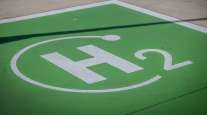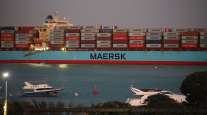Bloomberg News
Ship Orders Slump 50% With Owners Unsure Which Fuel to Use

[Ensure you have all the info you need in these unprecedented times. Subscribe now.]
Ship owners facing looming deadlines to use less-polluting fuels have slashed the number of new vessels on order because they don’t know which alternative technology to switch to.
Ammonia, hydrogen, biofuels and electrification are some of the many contenders to power the world’s future merchant fleet, but most are only in the trial stage and won’t be scalable for at least a decade. With the life of a commercial ship averaging about 20 years, opting for a technology that doesn’t take off could be very costly.
But owners are running out of time to make the choice. In 2018, the International Maritime Organization set a target to cut shipping’s greenhouse-gas emissions in half by 2050 from 2008 levels. The deadline prompted some ship owners to hold off on new orders until it became clearer which new fuels would be the best option — a decline that has turned into a slump with the subsequent global trade disputes and the pandemic.
Orders fell almost 10% in 2019 and then more than 50% in 2020 to the lowest mark in at least two decades, IHS Markit data shows. If activity doesn’t pick up, that could lead to a dearth of vessels and a spike in freight rates in a few years.

“People aren’t ordering ships because we don’t know what to fuel them with,” said Morten Aarup, head of market research at Danish vessel owner D/S Norden A/S. “Engineers, ship designers need to come together” urgently to find the best solution, he said in a recent panel discussion on shipping trends.
Ship owners who fail to switch to new, cleaner vessels could find themselves at a competitive disadvantage as more customers demand environmentally friendly transport. About 12.3% of vessels on order have alternative-fuel propulsion, compared with just 0.6% of the current global fleet, according to data from Drewry Maritime Services.
But the use of alternative fuels in shipping is still in its infancy, with many of the big ship owners pursuing other methods of powering their vessels. Trafigura Group, one of the world’s biggest energy traders, has a stake in a company selling marine biofuels, vessel classification society Lloyd’s Register has given approval in principle to several ammonia-fueled ship projects, and Swedish tanker line Stena Bulk AB is planning to run some of its vessels on used cooking oil.
The IMO’s targets in 2018 called for a 40% reduction in the carbon intensity of international shipping by 2030 and a 70% drop by 2050 from 2008 levels. Carbon intensity compares the amount of emissions to a unit of economic output. Those goals may become even more ambitious when the United Nations agency reviews them in 2023.
The IMO also introduced rules at the start of 2020 that banned marine fuel containing more than 0.5% sulfur for ships not fitted with pollution-reducing scrubbers.

A worker passes a propeller during repair work on a dredging vessel. (Nathan Laine/Bloomberg News)
The targets have contributed to the drop in new vessel orders, said Jayendu Krishna, a director at Drewry. While several alternative fuel projects have begun, it’s unclear which ones will be scalable, he said.
Liquefied natural gas is a leading contender for a transition fuel on the way to full decarbonization, just as it is in electricity generation. Royal Dutch Shell Plc is set to charter 40 dual-fuel barges for use on the Rhine River that can run on it. While the gas is still a fossil fuel, it’s CO2 emissions are lower than conventional marine fuel, and it’s readily available. LNG-fueled ships already make up 8% of new vessel orders, said Krispen Atkinson, a principal consultant at IHS Markit.
Using LNG would cut greenhouse gas emissions for shipping companies by almost 20% compared with fuel oil, said Christos Chryssakis, business development manager at DNV GL, a maritime advisory and verification provider.

How can we control an unruly trucking tech stack and streamline fleet management practices? Host Seth Clevenger speaks with Ray Greer, CEO of Omnitracs, which acquired SmartDrive last year. Hear a snippet, above, and get the full program by going to RoadSigns.TTNews.com.
A.P. Moller-Maersk, the world’s biggest container line, takes a different view. “There is no time for so-called transitional fuels,” Chief Technical Officer Palle Laursen said.
The Danish company is instead aiming for net-zero-emission fuel solutions only and sees fuels based on ammonia, alcohols and alcohol-lignin blends as the most promising, he said. Maersk has kept its fleet capacity flat since 2018 and hasn’t invested in large new vessels recently, Laursen said.
The Maersk Group ranks No. 4 on the Transport Topics Top 50 list of the largest global freight carriers.
Ammonia and hydrogen are probably the clean-fuel favorites at the moment, according to IHS’ Atkinson. Electrification of ships is another possibility, although due to power-to-weight ratios, it will probably only be practical for vessels operating on shorter routes, he said.
“When owners are considering new buildings, they’re very confused,” DNV GL’s Chryssakis said. Future fuels won’t be available at scale until at least 2030 and, while all solutions need to be explored, the industry can’t afford to wait, he said.
Want more news? Listen to today's daily briefing:
Subscribe: Apple Podcasts | Spotify | Amazon Alexa | Google Assistant | More




